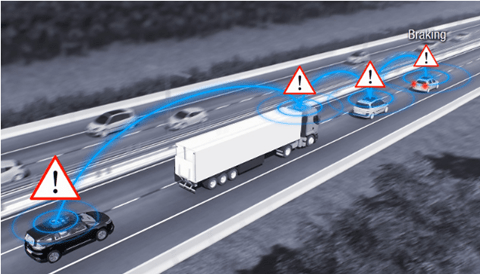
Connected cars: How technology offers new solutions to today’s transport problems
In this blog, we dive deeper into the latest developments in connected cars to explore how advanced information and communication technologies can offer new solutions to today’s transport problems.
Transport has become essential in everyday life, but ever-increasing road traffic presents serious challenges in terms of congestion, safety and the environmental impact. At LeasePlan, we’re continuously asking ourselves What’s next in mobility? In this blog, we dive deeper into the latest developments in connected cars to explore how advanced information and communication technologies can offer new solutions to today’s transport problems.
Connected car technology
Existing stand-alone advanced driver assistance systems (ADAS) help drivers to maintain a safe speed and distance, stay in lane, avoid overtaking in potentially dangerous situations and safely navigate intersections. In recent years, to further magnify the benefits of such safety systems, there has been increasing focus on connected car technology, which is commonly referred to in the industry as a cooperative intelligent transport system (ITS). This technology enables individual vehicles to continuously communicate with each other (V2V) and/or with the road infrastructure (V2I). Cooperative ITS can greatly increase the quality and reliability of information about vehicles, their locations and the road environment. It embraces a wide variety of communications-related applications aimed at increasing road safety by giving drivers advanced warning of local safety hazards, minimising the environmental impact, improving traffic management and maximising the benefits of transportation for commercial users and the general public alike.
ITS – How does it work?
In-car sensors and controllers input and analyse data such as vehicle speed, steering-wheel angle, tyre grip, windscreen-wiper activation and airbag triggering. The results of the analysis are indicative of traffic conditions and possibly hazardous situations such as ice, obstacles or accidents. Cars equipped with either 5G or Wi-Fi technology (ITS-G5) can send a warning message if a problem is detected (e.g. if they have broken down or have stopped suddenly and present a safety risk). In case of ITS-G5 technology, this is transmitted using a communication protocol via a Wi-Fi-like radio link that is specially engineered for use with moving vehicles and has a range of up to around 1,000 metres. Warning messages can be picked up either directly by other connected vehicles in the vicinity or by stationary communication units at the roadside, which in turn can send signals to vehicles and to a server that centralises information and updates it in real time.
For example, when a vehicle approaches an accident site it sends out a warning signal that is received by the cars behind it. These then relay the message to alert other vehicles, and so on. In addition, the warning signal can be picked up by a stationary unit in the vicinity of any of these cars, and this unit automatically notifies the central system, which will alert the emergency services accordingly. A similar procedure can be triggered for any number of potentially hazardous incidents such as animals on the road, temporary roadworks, traffic jams, landslides, etc. In time, it may even be possible for drivers to receive advance warning of motorcycles and tractors on the road.
With the Golf 8, Volkswagen(i) is one of the first car manufacturers to fit a V2I communication system as standard. It uses ITS-G5 technology(ii) based on Wi-Fi connectivity. Other manufacturers such as Renault and Toyota are also actively working on equipping vehicles with ITS-G5 technology. Meanwhile, another group of car manufacturers – including BMW, Daimler and Ford – are promoting the 5G-based (iii) cellular network in a cross-sector partnership between the telecom and automotive industries.
We are entering a new age in which vehicles are increasingly able to exchange safety-critical information with other nearby vehicles and roadside infrastructure thanks to technology. Vehicle-to-vehicle and vehicle-to-infrastructure communication can help to optimise road safety and reduce the number of accidents and casualties. However, with different OEMs currently working on different solutions, interoperability is still an issue. Connected cars will only realise their full potential when all vehicles are based on compatible systems and harmonised standards.
Connected car glossary
V2V = Vehicle-to-vehicle V2I = Vehicle-to-infrastructure V2P = Vehicle-to-pedestrian V2N = Vehicle-to-network applications V2X = Vehicle-to-everything (mix of V2V, V2I, V2P and V2N)
Sources
- (ii) ITS-G5 is a local beacon-based technology transmitting data between vehicles and infrastructure using special frequencies and protocols designed purely for transport
- (iii) 5G is the fifth-generation technology standard for cellular networks




